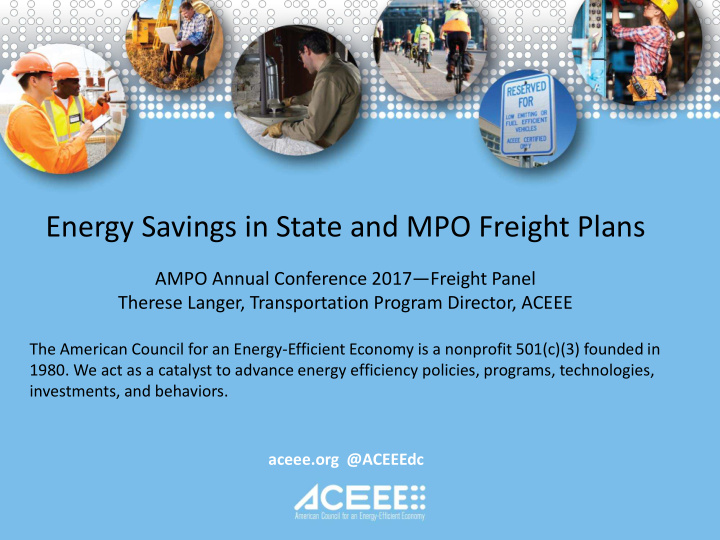



Energy Savings in State and MPO Freight Plans AMPO Annual Conference 2017 — Freight Panel Therese Langer, Transportation Program Director, ACEEE The American Council for an Energy-Efficient Economy is a nonprofit 501(c)(3) founded in 1980. We act as a catalyst to advance energy efficiency policies, programs, technologies, investments, and behaviors. aceee.org @ACEEEdc
ACEEE’s Transportation Program • Vehicle fuel efficiency: CAFE standards, trucks and bus standards, advanced technologies • Consumer resource: • System efficiency • Urban mobility • Sustainable freight • With policy team: scorecards, technical assistance
State Energy Efficiency Scorecard • Map shows results for all energy- consuming sectors • Transportation energy efficiency: 10 out of 50 points • State freight plan: 1/2 point if plan includes multimodal strategies, 1/2 points if it includes fuel-efficiency or GHG reduction goal. • 1 pt.--1 state; 0.5 pt — 31 states; 0 pts.--remainder
City Energy Efficiency Scorecard Transportation : 30 out of 100 points
City Scorecard--Freight Metrics • 1 point: At least one freight efficiency strategy, e.g. urban consolidation centers, last-mile solutions, off- hours delivery programs. • 1 (additional) point: Sustainable freight plan or a freight mobility plan w/ multiple strategies to increase efficiency. • 1 point: City served by real-time application or service for freight/package delivery (Convoy, Transfix). Results: NYC — 3 pts; Portland and Seattle — 2 pts; 11 others — 1 pt.
Importance of freight sector • Energy: Freight accounts for 18% of US oil consumption • Environment (USEPA): • Transportation responsible for up to 30% of all global emissions, including particulate matter, methane, carbon and other harmful air pollutants • Freight fastest-growing transport emissions in U.S. and globally • Ports and other communities near to freight hubs are disproportionately impacted • Economy (USDOT): • Between 2012 and 2045, US freight activity will grow by about 50% to 17 million tons and more than double in value to $37 trillion. • In 2015, freight-intensive industries generated 47%, or 62.13 million, of 132.2 million total U.S. jobs.
Central question: How to promote freight energy efficiency while meeting economic and other objectives for freight systems?
“Phase 2” Fuel Efficiency and GHG Standards for Heavy-Duty Vehicles • Final rule published October 2016 • With Phase 1, 37% reduction in fuel consumption of new heavy-duty vehicles • Current challenges to trailer requirements — court, EPA, Congress
EE opportunities: urban freight • Trip consolidation, neighborhood package pickup locations, cargo bikes, off-hours delivery Interface with intercity freight movement •
EE opportunities: intercity freight • Routing, driver behavior • Automated and connected vehicles, e.g. platooning • Collaborative shipping • More multimodal • Network, distribution center optimization; land use planning • 3PLs, migration to the cloud Recurring themes: data and technology
Role for government • Invest in shared infrastructure, networks, distribution facilities • Provide information (data, tools), forum for discussion • Guide, and remove barriers for, innovative service providers
Federal freight efficiency policy • Has received considerable attention from both Congress (bipartisan!) and the administration in recent years • MAP-21 • National Highway Freight Network • National Freight Strategic Plan • National Freight Advisory Committee • Freight performance measure • State freight plans • But focus on highway freight movement; not much on energy and sustainability issues
Federal freight efficiency policy (cont.) • FAST Act • Multimodal • Dedicated $ for freight • Rules and guidance • State and Metro Planning Rule • Freight performance measure: measurement of travel time reliability on the Interstate System • Also in 3 rd rule: GHG measurement • State freight plan guidance
Federal requirement for GHG measurement • Rule: States and MPOs must measure % ΔCO 2 from on-road mobile sources, relative to 2017 levels, and set reduction goals • Part of NHS/Freight/CMAQ performance management rule adopted 1/18/17 • FHWA delayed effective date of reporting requirement, then suspended it (5/19/17) • Several states sued (7/17 and 9/17) • Effective date of October 2018 reinstated by FHWA • FHWA issued NPRM on 10/5/17 to repeal GHG measure; comments due 11/6/17
State freight plans • Final guidance references resiliency, climate change, innovative technologies and operational strategies; but very limited requirements • Plans must be in place by 12/4/17 to obligate formula funding under NHFP (not multimodal elements) • Guidance emphasizes: • Inclusion of MPOs in state freight advisory committees • Alignment between freight plans and both STIPs and TIPs
MPO freight policy and planning opportunities • Frameworks for federal and state processes to plan and evaluate freight projects are unfinished business • Some MPOs will be addressing: a) GHG/ energy/sustainability goals (which may have been adopted at the city level), and b) multimodal issues (including port and urban freight issues) • For these issues, MPOs can build on/draw from federal and state frameworks to set a vision for freight and milestones to get there.
Conclusion • Efficiency of freight movement is important to meeting energy efficiency and environmental objectives • MPOs can pursue through: • Metro freight plan • State DOT (freight plan advisory committee) • Project programming • New opportunities through data, technology advances • Input to federal freight planning • Consider setting freight-specific targets for: • Energy efficiency (energy per ton-mile) • Mode share (e.g. % intermodal entering metro region) • GHG (e.g. total freight-related CO 2 )
tlanger@aceee.org Upcoming ACEEE Conferences Behavior, Energy and Climate Change Conference October 15 — 18, 2017 Sacramento, CA Litchfield Park, National Conference on Energy Efficiency as a Resource October 30-November 1, 2017 AZ Hot Water Forum March 20-22, 2018 Portland, OR Energy Efficiency Finance Forum May 21-22, 2018 Tarrytown, NY International Energy Efficiency Workshop June, 2018 Washington, DC Summer Study on Energy Efficiency in Buildings August 12-17, 2018 Pacific Grove, CA The top convener in energy efficiency. aceee.org/conferences
Recommend
More recommend